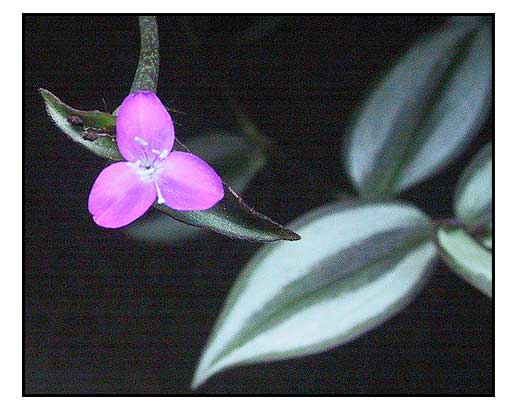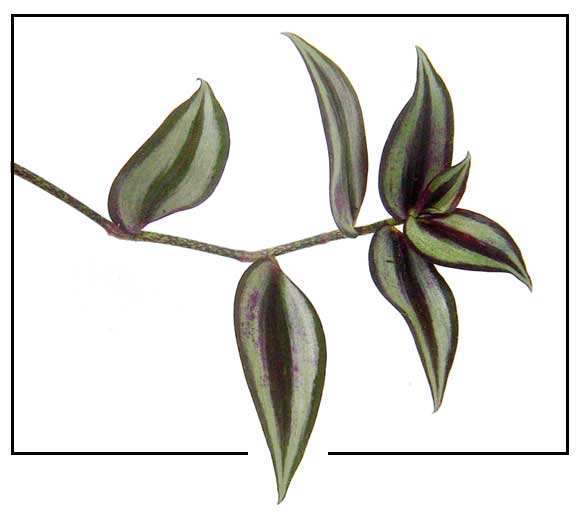|

Gen info
- Tradescantia is a genus of 85 species of herbaceous perennial wildflowers in the family Commelinaceae, native to the Americas from southern Canada to northern Argentina, including the West Indies. Common names of members of the genus include inchplant, wandering jew, spiderwort, dayflower, and trad. (19)
- Etymology: The genus name Tradescantia was chosen by Carl Linnaeus, which honors the English naturalists and explorers John Tradescant the Elder (c. 1570s-1638) and John Tradescant the Younger (1608-1662), who introduced many new plants to English gardens.
- Etymological snippets: Inchplant refers to the plant's fast growth; or alternatively, that the leaves are an inch apart on the stem. Spiderwort refers to the sap which dries into web-like threads when the stem is cut. Dayflower, shared by other members of the family, refers to the flowers that open and close within a single day. Wandering jew, a controversial name and offensive to some, derives from the Christian myth of the wandering jew, condemned to wander the earth for taunting Jesus on the way to his crucifixion. Suggestions have been made to change it to "wandering dude" or "wandering willie".In Spanish, Tradescantia plants are sometimes referred to as flor de Santa Lucia (St. Lucy's flower), referring to the saint's reputation as the patron of sight and the use of the plant juice as eye drops to relieve congestion. (19)
Botany
• Zebrina pendula is a vigorous branching
creeper with succulent leaves and stems, rooting freely at the nodes.
Leaves are sessile and alternate, ovate and short acuminate, the upper surface dark green to
purple, with 2 longitudinal silver stripes adaxially. The under-surface is dark purple. Flowers
are purple-pink, or white, small and in terminal clusters, supported by two large foliage-like, narrow, ciliate bracts. Sap is mucilaginous and clear.
 • Tradescantia zebrina has attractive zebra-patterned leaves, the upper surface showing purple new growth and green older growth parallel to the central axis, as well as two broad silver-colored stripes on the outer edges, with the lower leaf surface presenting a deep uniform magenta. Leaves are bluish green and usually have two longitudinal stripes that are silvery on the surface and purple on the underside. When chronically exposed to long periods of intense sunlight, the variegation fades and the leaf becomes purple throughout. Leaf sheaths are thin and translucent, 8 to 12 mm long and 5 to 8 mm wide, at the mouth they are long, otherwise glabrous or slightly hairy. The low-lying, slightly succulent, perennial, herbaceous plant often forms dense mats or colonies, which is done primarily by natural formation of taproots. On the nodules of the shoot are root approaches, from which roots develop in permanent contact with water or a sufficiently moist substrate under favorable conditions within a day. The shoots are glabrous or hairy. The stalked, parallel-veined leaves are mostly ovate, 4 to 10 cm long and 1.5 to 3 cm wide, pointed towards the tip, rounded to the base. The upper surface is glabrous to mildly hairy, the underside hairless to averagely hairy, ciliate towards the leaf base. The structure of the flower—usually from the three pink petals and the white sexual organs—is similar to that of the other Tradescantia, but unlike what happens in those, the plant branches off thanks to new buds whose attachment starts below that of the leaf (and not above). Flowers are in groups, supported by two large foliage-like, narrow, ciliate bracts. The hermaphrodite, radial-symmetrical flowers are threefold. Three overgrown sepals are 2 to 3 mm long. The three only grown at the base petals are ovate-blunt, pink to purple and 5 to 9 mm long. Six equally sized stamens are violet hairy. Three carpels have become a top permanent ovary grown. They form capsule fruits that contain gray-brown seeds. (17) • Tradescantia zebrina has attractive zebra-patterned leaves, the upper surface showing purple new growth and green older growth parallel to the central axis, as well as two broad silver-colored stripes on the outer edges, with the lower leaf surface presenting a deep uniform magenta. Leaves are bluish green and usually have two longitudinal stripes that are silvery on the surface and purple on the underside. When chronically exposed to long periods of intense sunlight, the variegation fades and the leaf becomes purple throughout. Leaf sheaths are thin and translucent, 8 to 12 mm long and 5 to 8 mm wide, at the mouth they are long, otherwise glabrous or slightly hairy. The low-lying, slightly succulent, perennial, herbaceous plant often forms dense mats or colonies, which is done primarily by natural formation of taproots. On the nodules of the shoot are root approaches, from which roots develop in permanent contact with water or a sufficiently moist substrate under favorable conditions within a day. The shoots are glabrous or hairy. The stalked, parallel-veined leaves are mostly ovate, 4 to 10 cm long and 1.5 to 3 cm wide, pointed towards the tip, rounded to the base. The upper surface is glabrous to mildly hairy, the underside hairless to averagely hairy, ciliate towards the leaf base. The structure of the flower—usually from the three pink petals and the white sexual organs—is similar to that of the other Tradescantia, but unlike what happens in those, the plant branches off thanks to new buds whose attachment starts below that of the leaf (and not above). Flowers are in groups, supported by two large foliage-like, narrow, ciliate bracts. The hermaphrodite, radial-symmetrical flowers are threefold. Three overgrown sepals are 2 to 3 mm long. The three only grown at the base petals are ovate-blunt, pink to purple and 5 to 9 mm long. Six equally sized stamens are violet hairy. Three carpels have become a top permanent ovary grown. They form capsule fruits that contain gray-brown seeds. (17)
Distribution
- Popular as a ground cover, tending to become invasive, aggressively colonizing new areas when left undisturbed,
- Native to Belize, Colombia, Costa Rica, El Salvador, Guatemala, Honduras, Mexico Central, Mexico Gulf, Mexico Northeast, Mexico Northwest, Mexico Southeast, Mexico Southwest, Nicaragua, Panamá. (4)
Constituents
- Study isolated three components: ß-sitosterol, 3β, 5α, 6β-trihydroxy stigmast and succinic acid. (see study below) (7)
- Study isolated
three components viz. ß-sitosterol, 3ß, 5a, 6ß-trihydroxystigmast and succinic acid. (see study below) (3)
- Preliminary phytochemical screening of leaves yielded sterols, saponins, flavonoids, tannins, carbohydrates, proteins and aminoacids.
Properties
- Studies have shown anti-proliferative properties.
- Skin irritation may result from repeated contact or prolonged handling of the plant, especially from the clear, watery sap, unique to T. zebrina. (17)
- Studies have suggested antineoplastic, antiarrhythmic, antibacterial, antioxidant, acetylcholinesterase inhibitory, anticancer, lipoxygenase inhibitory, antiproliferative, anti-inflammatory, antinociceptive properties.
Parts
used
Leaves and stems.
 Uses Uses
Edibility
- In Mexico, Matali, a beverage made of lemon and sweetened decoction of leaves, is used as a cold tonic drink.
Folkloric
- No reported
folkloric medicinal use in the Philippines.
- Elsewhere, used for treatment of common cold, hypertension, tuberculosis,
uterine disorders.
- In Jamaica, used for
treatment of high blood pressure, coughs, tuberculosis, and as cold cure.
- In combination with other herbs, used to purify the blood and for amenorrhea.
- In China, leaves applied to reduce swellings. Also used for hemorrhoids, blood in the stools, tuberculous cough, conjunctivitis, kidney infections.
- Leaves mixed with other types of herbs as a blood tonic and to treat amenorrhea.
- In Mexico, used for treating diarrhea.
- Leaf decoction used for diabetes.
- Decoction of leaves used for urinary tract infections and for flushing the kidney.
- In Afro-Cuban Santeria, decoction of leaves drunk to flush gravel out of the kidneys and bladder, break the crisis of colitis, and provoke menstruation. (Cabrera, 1971) (5)
- In Guyana, leaves used as tea for cleansing blood and treating influenza. (10)
Others
- Landscaping: Used as houseplant and ground-cover, aggressively colonizing new areas when left undisturbed. It tends to become invasive if not properly maintained.
Studies
• 3-Ecdysone / Anti-Arrhythmic Effect: Study isolated ß-ecdysone from Z. pendula, and in animals has shown elimination of arrhythmia induced by aconitine. (2)
• Antineoplastic Components: Study isolated three components identified as β-sitosterol, 3β, 5α, 6β-trihydroxy stigmast and succinic acid. Anti-tumor activity was seen in ascites-type-180 sarcoma of mice: 43% (160mg/kg) for succinic acid, 91% (100mg/kg) for β-sitosterol and 98%(100mg/kg) for 3β, 5α, 6β-trihydroxystigmast. (3)
• Anti-Cancer / Anti-Proliferative: Study evaluated the anticancerous properties of Tz extracts against two cancer cell lines, A-549 lung carcinoma and SCC-13y malignant keratinocyte cells. Tz treatment resulted in decreased cellular growth. Tz treatment was also tested on non-cancerous cell line of HFF-human foreskin fibroblasts cells to determine relative toxicity of the extract. Results showed inhibitive effects of Tz extracts on cancerous and non-cancerous cells. (6)
• Antineoplastic Components: Study isolated three components from Zp: ß-sitosterol, 3β, 5α, 6β-trihydroxy stigmast and succinic acid. Anti-tumor rates were 43% (160mg/kg) for succinic acid, 91% (100 mg/kg) for ß-sitosterol, and 98% (100 mg/kg) for 3β, 5α, 6β-trihydroxystigmast in anti-cancer test of ascites type-180 sarcoma of mice. (7)
• Effect on Human Cancer Cells: Study evaluated the anticancer characteristics of Tradescantia zebrina and Tradescantia fluminensis. Study confirmed the general inhibitory effects of T. zebrina and T. fluminensis extracts on cancerous and non-cancerous cells. (8)
• Antioxidant / Antibacterial / Leaves: Study evaluated the antioxidant and antibacterial activity of five Commelinaceae methanolic leaf extracts. Antioxidant activity was evaluated by TPC, TTC, TFC assays, while antioxidant activities were measured by DPPH, FRP, and FIC. Of the five plants, the methanolic leaf extract of T. zebrina showed the highest antioxidant content and activity, and exhibited antibacterial activity against six Gm-positve and two Gm-negative bacterial species. (12)
• Antioxidant / Acetylcholinesterase Inhibitory Activity / Leaves: Study evaluated the in vitro antioxidant and acetylcholinesterase inhibitory activity of methanol extract of leaves of T. zebrina.
The ME of TZ at 100.00 µg/ml and 10.00 µg/ml showed significant inhibition of acetylcholinesterase activity (p<0.05) of 14.0% and 15.3%, respectively. The extract also exhibited 18.1% reduction and capability to scavenge free radical against DPPH. (13)
• Silver Nanoparticles / Antibacterial / Leaves: Study reports on the biosynthesis of silver nanoparticles using aqueous leaf extract of T. zebrina and its antibacterial activity against common human pathogenic bacteria viz. S. epidermis, S. aureus, S. enterica, E. coli and B. cereus. Results showed good zones of inhibition comparable to amikacin. (14)
• !5-Lipoxygenase Inhibition / Leaves: Study evaluated the 15-lipoxygenase inhibitory activity of methanolic leaf extracts of Commelina benghalensis, Tradescantia fluminensis, and Tradescantia zebrina. All the extracts inhibited the action of 15-lipoxygenase at concentration of 0.2 µg/mL. T. fluminensis and Tradescantia zebrina exhibited higher than 50% inhibition. (16)
• Bioactive Compounds for Blood Coagulation / Antimicrobial / Leaves: Extracts of Tradescantia zebrina, Tagetes minuta, and Codieum variegatum have been reported to be used for blood clotting. Study evaluated the crude extract of these plant species used to accelerate blood clotting. All the extracts were found to be abundant in iron, copper, and phytochemicals. All extracts showed moderate inhibition of E coli and C. albicans, and mild inhibition of S. aureus. The extracts showed trace amounts of vitamin K and moderate amounts of calcium. (18)
• Antinociceptive / Anti-Inflammatory / Aerial Parts: Study evaluated the in vivo anti-inflammatory and antinociceptive potential of T. zebrina ethanol extracts and fractions in Wistar rats. Formalin and carrageenan tests were used for evaluating antinociceptive and anti-inflammatory properties. Ethyl alcohol and chloroform fractions decreased licking of foot significantly in the formalin test (p<0.001). The ethanol extract decreased paw edema caused by carrageenan at doses of 100 and 300 mg/kg relative to control (p<0.001). No mortality was seen in acute toxicity test. Total phenolic content showed 76.88% µg GAE/mg. Results showed antinociceptive and anti-inflammatory effects. Further studies were suggested for potential isolation of bioactive compounds. (20)
Availability
Wild-crafted.
|




 Uses
Uses

